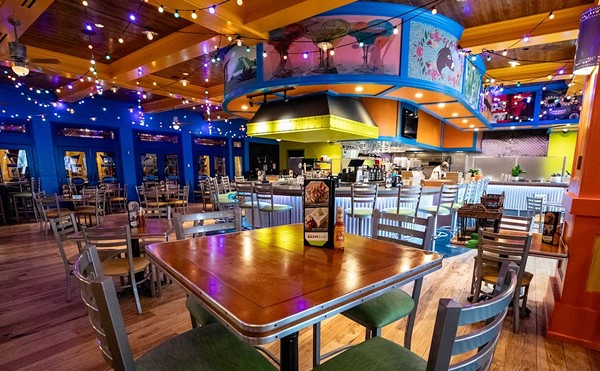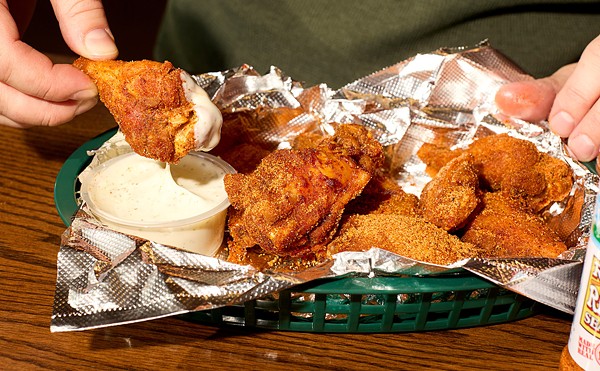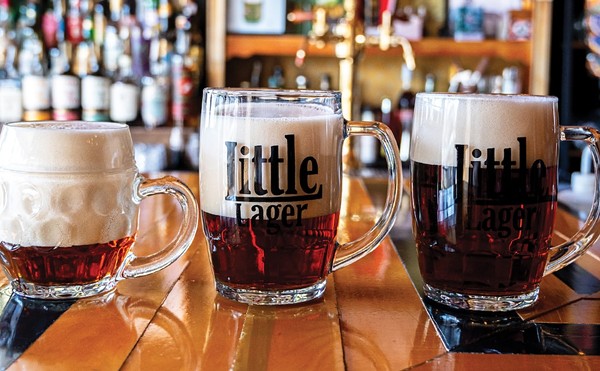Against that backdrop, the vision that's now planted in my brain is one of an incongruous (for downtown) row of wind-chime bells hanging outside a long-dormant downtown hospitality landmark, once known as Carberry's Pit of the Seventh Olive but now refurbished and renamed Sen, the Thai word for "noodle."
It's been so long since that space was active that I hardly remember what it used to look like, but now the glass door leads to a stairway paved with the same blond wood that ornaments many Thai restaurants, at the bottom of which is a host station that quickly reflects why Thailand markets itself as the "land of smiles." On a weekend-evening visit, it might have appeared that the hostess was simply overjoyed that someone had finally showed up; during a weekday lunchtime, however, we got the last of the 12 tables and no less of a radiant greeting, as well as a couple of visits during the course of the meal with the same wide smile querying whether everything was up to our expectations.
Despite the windowless nature of the basement space, the restaurant is quite cheery, with brick floors and mint-green walls, on which are displayed photographs of temples, along with a Buddhist mural and a proverb carved from wood in the gorgeously curlicued character set of the Thai language. Our waitress translated it as "The straight way is not easy in life."
Each of the ebonized-wood tables sports a condiment tray of kettle-shaped miniature blue glass containers holding oils, chiles and other flavorings. This preciseness in presentation extends to the meal proper, where each element is neatly compartmentalized and arranged on a forest-colored plate and left to the diner to mix and match.
In addition to the sheer friendliness, all meals start with a complimentary portion of toast strips served with a chile-enhanced peanut sauce, a "spice depth charge," as one of my dining partners described it. And although it's certainly possible to pick and choose milder dishes on Sen's menu, doing so avoids exposure to the excellent balance that's achieved among the sweetness of coconut, the nuttiness of peanut, the soapy bite of cilantro and the sweet, almost licorice-y taste of Thai basil that blends smoothly with the heat in every dish in which chiles are used.
Individual appetizer orders run from $3.90 to $5.90, and groups of two or more may graze through several with the Singha platter ($9.90) or the vegetarian Rama platter ($8.90), each containing Thai spring rolls and corn todmun, but with tofu and taro-root fritters replacing shrimp todmun and chicken satay in the vegetarian version. The Thai spring rolls were exemplary of the quality that pervaded all of our meals at Sen -- obviously freshly cooked, fried but not at all oily, and featuring thin slivers of mushroom that fairly well burst with flavor, passing it along to both the neutral background of cellophane noodles and to the mixed vegetables that made up the rest of the interior of the roll. Unlike the practice at some Thai restaurants, the satay at Sen was prepared in the kitchen (as opposed to being finished by the diner on a minigrill at the table), resulting in strips of breast with a light-yellow tinge of curry, served with a peanut-sesame dipping sauce. The corn todmun would make a wonderful gourmet munchie, and the shrimp todmun was reminiscent of a Japanese tempura preparation.
As previously noted, the presentation style at Sen involves displaying the discrete elements of each dish and letting the diner decide in what proportions to combine everything, with obvious care having been taken to arrange rice into domes, shredded vegetables into nests, and so forth. My favorite of everything we sampled was the roast-duck curry ($7.90), in which some of the duck meat still clung to crispy skin, resulting in a sort of "duck bacon" flavoring. This was mixed into a soupy tropical base of pineapple and red and green bell peppers, which was served in a separate bowl so that it could be ladled over rice according to the diner's taste.
Another simple but elegant (and no doubt healthy) dish, a perfect light meal, was the Sen salad ($3.90), a large portion of shredded cabbage and carrot, much like a cole slaw, but fired with chiles and augmented with razor-thin slices of cucumber and sliced red bell pepper, along with a fresh lime and stems of fresh cilantro. It's acontinued on next pageNoodlescontinued from previous pageneat flavor trick in that the cabbage naturally draws off some of the chile fire, allowing you to enjoy the flames without being consumed by them.
As for the restaurant's namesake, noodles are best represented in the dish called pad thai, available with chicken or shrimp or in a vegetarian form. We tried the added shrimp, and, again, each element of the dish was segregated on the plate -- about a half-dozen medium shrimp, shredded carrots, chopped peanuts and a lime quarter, all arranged around the noodle centerpiece, which included turnip, egg, tofu, bean sprout, and sweet and sour tamarind.
Desserts are certainly exotic but also enjoyable -- the coconut "pudding" includes sticky rice and sweet beans, along with taro root for texture, all floating in coconut milk, and the homemade ice creams augment tropical flavors with peanut and even corn, but, once again, this actually works.
About eight regular wines and one plum wine are available by the glass or bottle, and there are a bunch of A-B beers, but nothing seems to balance a Thai meal better than Singha, the light but full-bodied Thai malt liquor.
The servers were terribly eager to please, but there was a slight element of "Hey, kids, let's put on a restaurant" to the youthful staff. In one case we experienced a comprehension problem, resulting in the Sen salad's coming out in place of the Sen seafood salad; at another time during our evening visit, the staff retreated to the kitchen for long periods. The host-station staff should also be made aware that answering "Hello?" (and nothing else) is not conducive to promoting the restaurant and that accepting reservations is a better marketing tack than telling the potential visitor, "We're not busy -- you don't need a reservation."
But these are growing pains, and you know that the owners' hearts are in the right place when the menu proclaims: "Sen is committed to making your dining experience memorable and your life more like a noodle: simple, natural and long."
If you haven't ventured downtown lately, the bells of Sen toll for thee.
SEN, 224 N. Seventh St. (at Olive, downtown), 436-3456. Hours: lunch, 11 a.m.-2:30 p.m. Mon.-Sat.; dinner, 5-10 p.m. Tues.-Sat. Entrees: $3.90-8.90
'





